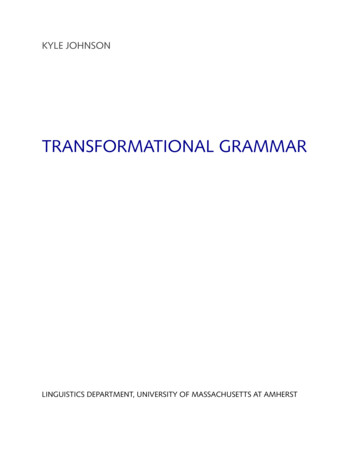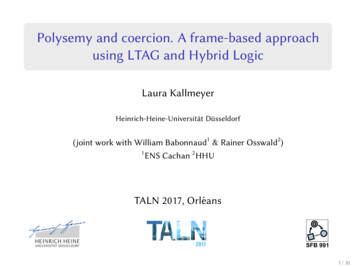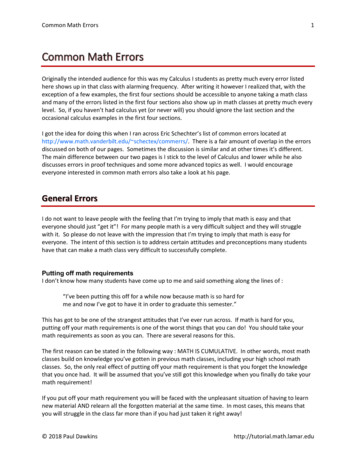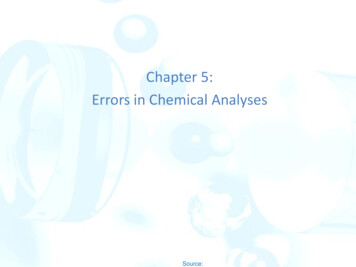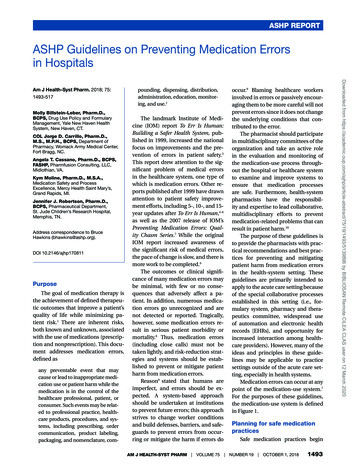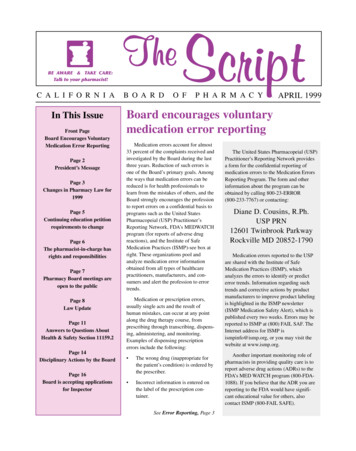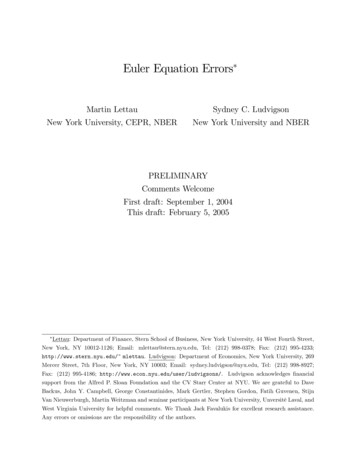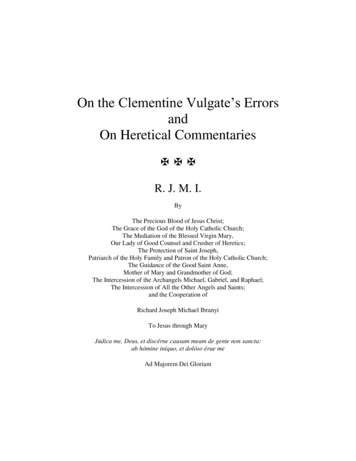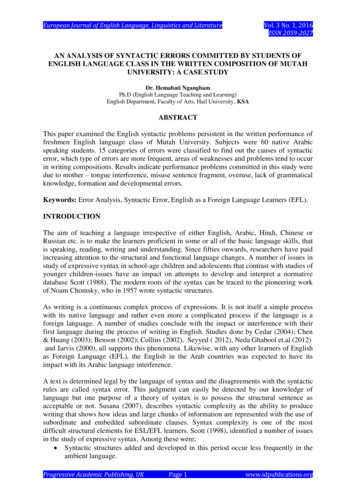
Transcription
European Journal of English Language, Linguistics and LiteratureVol. 3 No. 1, 2016ISSN 2059-2027AN ANALYSIS OF SYNTACTIC ERRORS COMMITTED BY STUDENTS OFENGLISH LANGUAGE CLASS IN THE WRITTEN COMPOSITION OF MUTAHUNIVERSITY: A CASE STUDYDr. Hemabati NgangbamPh.D (English Language Teaching and Learning)English Department, Faculty of Arts, Hail University, KSAABSTRACTThis paper examined the English syntactic problems persistent in the written performance offreshmen English language class of Mutah University. Subjects were 60 native Arabicspeaking students. 15 categories of errors were classified to find out the causes of syntacticerror, which type of errors are more frequent, areas of weaknesses and problems tend to occurin writing compositions. Results indicate performance problems committed in this study weredue to mother – tongue interference, misuse sentence fragment, overuse, lack of grammaticalknowledge, formation and developmental errors.Keywords: Error Analysis, Syntactic Error, English as a Foreign Language Learners (EFL).INTRODUCTIONThe aim of teaching a language irrespective of either English, Arabic, Hindi, Chinese orRussian etc. is to make the learners proficient in some or all of the basic language skills, thatis speaking, reading, writing and understanding. Since fifties onwards, researchers have paidincreasing attention to the structural and functional language changes. A number of issues instudy of expressive syntax in school-age children and adolescents that contrast with studies ofyounger children-issues have an impact on attempts to develop and interpret a normativedatabase Scott (1988). The modern roots of the syntax can be traced to the pioneering workof Noam Chomsky, who in 1957 wrote syntactic structures.As writing is a continuous complex process of expressions. It is not itself a simple processwith its native language and rather even more a complicated process if the language is aforeign language. A number of studies conclude with the impact or interference with theirfirst language during the process of writing in English. Studies done by Cedar (2004); Chen& Huang (2003); Benson (2002); Collins (2002), Seyyed ( 2012), Neda Ghabool et.al (2012)and Jarvis (2000), all supports this phenomena. Likewise, with any other learners of Englishas Foreign Language (EFL), the English in the Arab countries was expected to have itsimpact with its Arabic language interference.A text is determined legal by the language of syntax and the disagreements with the syntacticrules are called syntax error. This judgment can easily be detected by our knowledge oflanguage but one purpose of a theory of syntax is to possess the structural sentence asacceptable or not. Susana (2007), describes syntactic complexity as the ability to producewriting that shows how ideas and large chunks of information are represented with the use ofsubordinate and embedded subordinate clauses. Syntax complexity is one of the mostdifficult structural elements for ESL/EFL learners. Scott (1998), identified a number of issuesin the study of expressive syntax. Among these were; Syntactic structures added and developed in this period occur less frequently in theambient language.Progressive Academic Publishing, UKPage 1www.idpublications.org
European Journal of English Language, Linguistics and Literature Vol. 3 No. 1, 2016ISSN 2059-2027The number of discourse contexts for studying syntax increases, (eg. Written as wellas spoken language, and informational in addition to narrative and conversationaldiscourse).Thus, this paper is a modest attempt to bring a broader discussion of what defines normalsyntactic ability in university age children and adolescents especially focusing on secondlanguage learners of English in particular Arabic – speakers. This study will help to find thecontinuing syntactic growth in the service of more effective discourse, either spoken orwritten. Hence, this type of research should be viewed as significant because it reflects thefeatures that distinguish the Arabs' English as a performance variety which develops whereEnglish is used as a foreign language, Kachru (1983). Investigating in these areas maycontinue to persist the specific difficulties face by the Arab learners of English as a secondlanguage at the beginning of their college education.REVIEW OF RELATED LITERATUREA wide range of materials have been found relating this present study. And considering themain purpose, only a few studies have been selected for reviews. Research dealt withinvestigating the errors produced by second language learners of English have been selectedin a way that investigating this subject choice can diagnose the areas of weakness andstrength in learners' English. As already mentioned, the role of the first language has longbeen considered as the main obstacle to a successful learning of another foreign language.Eventually, the context of English in the Arab countries does also have its impact on the typeof English learned, due to the Arabic English interference. Therefore, a better understandingof the first language (L1) influence in the process of EFL writing might help the teachers toknow students difficulties in learning English. Khaleel (1985) analysed the written errors ofBethlehem university students in the first year of their college education on the West Bank.He distinguished between grammatical errors, i.e., word order, concord and verb, andsemantic errors, i.e., lexis and collocation. The latter was found to impede communication.Kharma (1983), studied the syntactic difficulties faced by the Kuweiti high school students.His study was based on contrastive analysis of English and Arabic. He devised a test focusingon the problem areas and sorted out the frequency and types of the structural errors whichwere mostly related to tense. Kambal (1980) studied the written errors of the Khartoumuniversity students in Sudan and found that their errors fell in the areas of tense, verbformation, articles, concord and prepositions. To discover learning deficiencies in writingEnglish, Kao (1999) scrutinized 169 compositions from 53 Taiwanese college students whowere English major students. A total of 928 errors were found among which grammaticalerrors with the greatest frequency of 66 per cent, semantic errors occurred 18 per cent of thetime, and lexical errors occurred with the least frequency of 16 per cent. Lin (2002) alsoexamined 26 essays from Taiwanese EFL students at the college level. The results of thisstudy indicated that the four highest error frequencies were sentence structures (30.43 percent) wrong verb forms (21.01 per cent), sentence fragments (15.99 per cent), and wrong useof words (15.94 per cent) respectively.In a study by Kobayashi and Rinnert (1992), comparing translation as a strategy in L2composing vs. direct composing in the L2, the researchers found that as syntactic complexityincreased in the cognitively demanding translation task, awkward forms and transitionalproblems emerged which frequently interfered with the intended meaning. “The syntacticfeatures of English spoken by advanced bilingual Arabs”, by Atawneh (1994), examined theEnglish syntactic problems persistent in the performance of educated Arabs living in theProgressive Academic Publishing, UKPage 2www.idpublications.org
European Journal of English Language, Linguistics and LiteratureVol. 3 No. 1, 2016ISSN 2059-2027United States. Results indicate performance problems in the areas of (1) tense agreement; (2)relative clause construction; (3) indirect questions; (4) perfective tenses; and (5) use ofprepositions. He furthermore explains that the degree of deviation in these areas depends onboth amount of time spent in the united states and their educational level.Jayakar Mukundan (2008), at his similar study, " Malaysian ESL students' syntactic Accuracyin the usage of English Modal Verbs in Argumentative writing", examined the use of modalsin argumentative written tasks by Form 5 Malaysian secondary school ESL students. The aimof this study was to examine the use of English modals at the syntactic level from datapresented in the MCSAW Corpus. The research findings showed that Malaysian students hadlittle problem using modal verbs grammatically in argumentative writing. It was also foundthat Malaysian students preferred to use a lot of modals in their writings. However, the use ofthese modals was limited to a few words only. It was concluded that despite the inaccuraciesin terms of meanings, most students were able to use syntactically accurate modals in theirsentences. Zughoul (2002), also conducted similar study entitled, “inter language syntax ofArabic – speaking learners of English: the noun phrase. He concluded with a result indicatingthat noun phrase errors were second to verb phrase errors. He furthermore conveys that themost frequent noun phrase errors were in the use of articles, ordinals were used interchangeably, and quantifiers were confused as to their use with count / non count nouns.Al-Khasawneh,(2010), in his studies, "Writing for academic purposes: problems faced byArab postgraduate students of the college of business", aimed at investigating the academicwriting problems of the Arab postgraduate students of the College of Business at UniversityUtara Malaysia and to provide solutions to these problems. The findings of the study revealedthat the students faced problems in relation to vocabulary register, organization of ideas,grammar, spelling, and referencing .At a similar study tittled, "Investigating Pakistani ESLStudents’ Writing Problems on Convention, Punctuation and Language Use at TerritoryLevel", Anum Shahzadie et.al. aimed to investigate the three problematic areas of writtenlanguage convention, punctuation, and language use at territory level from students andteacher experience, using questionnaire and essay as the tools for examining the problems.The finding revealed that Pakistani students have problems in writing especially unable totackle the language use. A very similar study done by Neda,(2012), "Investigating MalaysianESL Students' Writing Problems on Conventions, Punctuation, and Language Use atSecondary School Level", aimed at investigating the challenges in three aspects of writingdevelopment process, namely conventions, punctuation, and language use (proper use ofgrammar) in secondary school level from students and teachers experiences. A questionnaireand an essay examination were utilized as the instruments of the study. The findings revealedthat Malaysian ESL students have problems in writing tasks, especially in language use(grammar) and punctuation. The first language interference was also very tangible in theirwritings. The study suggests some practical methods in order to cope with writingdifficulties.From this above reviews, it can be concluded that certain specific difficulties were foundfaced by second language learners. It can be seen that second language learners tend tooveruse coordinate clauses, at the same time, learners also have difficulties in tense, verbformation, articles, concord, prepositions, language use (grammar) and punctuation,vocabulary register, organization of ideas, spelling, and referencing lexical errors andsemantic errors. These specific difficulties were found to face the learners beginning at theircollege education investigating in these areas seems to be important in bringing a broaderscope in learning English as a second language. The theoretical framework of this paperProgressive Academic Publishing, UKPage 3www.idpublications.org
European Journal of English Language, Linguistics and LiteratureVol. 3 No. 1, 2016ISSN 2059-2027follows with the methodology, analysis and result of the collected data and finally discussionsconclusions drawn with suggestions made for further research.METHODOLOGYThis study was undertaken through an error analysis, to investigate why and what problemstend the freshmen English language class university students to have syntax error. This paperwould also help in finding the problematic areas of the interlanguage syntax error.Furthermore, it would also help in finding the problematic areas of the interlanguage syntaxof Arabic – speaking learners and to explore what is peculiar of the second language learner,which makes the language difficult to learn.Statement of the Subject“An Analysis of Syntactic Errors Committed by Students of English Language Class in theWritten Composition of Mutah University: A Case Study”Sample of the StudyThe main objective of conducting this study was to obtain the background information aboutthe proficiency of English as a second language in particularly analyzing at the syntax errorscommitted in writing compositions. The sample of the study comprised of sixty Englishlanguage class students of Mutah University for the second semester 2005/2006. All thesestudents had gone through 12 years in empowering the language at the class room entity, andwere now in the first year of a four year program in teacher training, preparing to be teachersof English as a foreign language. They were all native speakers of Arabic, representingpeople from urban and rural background with different socio-economic groups. This samplewas selected without the barriers of sex and religion. The researcher preconceived thesubjects to have been shared similar English proficiency levels and hence homogeneous.Thus, the sample formed a group quite representative of young educated learners.Research QuestionsIn order to fulfill a deeper analysis of this paper, the researcher postulated the followingresearch questions.(i)What are the causes of these syntactic errors?(ii)Which types of syntactic errors are more frequent in writing compositions?(iii) To diagnose the areas of weaknesses in the writing compositions.(iv)And what problems students tend to have in writing compositions.Research DesignSince, the study focuses at investigating the problematic areas of syntactic errors committedin writing compositions, the researcher postulated a set of syntactic error categories to beanalysed. Adjectives and adjectives phrases. Adverbs and adverb phrases errors. Noun – phrases errors. Sentence structure errors Word order errors.Progressive Academic Publishing, UKPage 4www.idpublications.org
European Journal of English Language, Linguistics and LiteratureVol. 3 No. 1, 2016ISSN 2059-2027The findings and the results of this study might contribute a wider spectrum of structures andfind a remedy for this critical period of college study. This also will investigate a positivechange in teaching literacy instructions.Analysis of the Collected DataThe process of analyzing the collected data was to examine the student performance. Thus,the procedure of analysing the error was taken in accordance with the following four steps(Huang: 2002).(i)Data collection(ii)Identification of errors(iii) Classification of errors into error types(iv)A statement of error frequency(i)Methods of Collecting DataA typology of errors based on a pilot project was established in which the major part was toanalyse a syntactic errors. Data was collected via written discourse completion tests, in theform of narrative essays. The subjects were asked to write in the class situation within a timelimit of 45 minutes, with permission from the head administrator. The researcher handcollected the completed samples, in order to ensure that all the samples collected from thesubjects were valid and non-revised first drafts. The subjects were asked to write manually,and to eliminate writing anxiety and to provide a clear perspective to the subjects a hard-copydrafts were provided and to provide confidentiality of the participants, all the samples wereencoded with numbers instead of the students names.The following writing prompt was presented to the participantsWrite a short essay on this following topic "The first day of the university".This task was given within a time limit of 45 minutes and the minimum page requirementwas one page. The essay should include with three main parts: Introduction, the Body of theEssay and the Conclusion. The subjects were guided to write as directly, concisely naturaland simple as possible. To add and develop more examples at the body of the essay and togive a personal opinions or the influence the event has had on you at the conclusion.(ii)Identification of ErrorsErrors of the collected data in the form of narrative essays were identified and classified intodifferent error categories by two raters who were reliable English grammar experts. Theresearcher also tried to interpret the structures as best as she could and emphases are put moreon syntactic error as this is the main theme for this research. The completed score sheets wasused to calculate error rates by Statistical Package for Social Science (SPSS) for dataanalysis. Absolute frequencies refer to the actual occurrence of errors, usually expressed bynatural numbers of errors, such as verb errors 838 (Huang: 2002).(iii)Classification of Errors into Error TypeThe errors were classified into different error categories – based on (Horney's: 1998), nineclassifications of error categories were chosen and six more were alerted from theconventional grammatical categories of the sample, thus, the researcher altogether classifiedthe typology into 15 categories. (See Appendix)Progressive Academic Publishing, UKPage 5www.idpublications.org
European Journal of English Language, Linguistics and Literature(iv)Vol. 3 No. 1, 2016ISSN 2059-2027A Statement of Error FrequencySince the error analysis used in this study focused especially at the syntactic structure,regardless of their writing skills. Expression of idea, organization and cohesion, the essayscoring involved error frequency counts for grammatical errors only. As English is foreignlanguage of the subjects, the researcher found errors committed because of the interference ofArabic, their native language. The sentences were found to be of direct translation from theArabic language such as, "I talked about first week in university", "the hostel is small, so Ifeared".Eventually, the errors were identified for each composition and counted according to thesubheading of the classification. Errors were counted if it occurred repeatedly. Thus, the errorrates were counted. The error rates in this study were obtained from dividing the absolutenumbers of errors by the total words the participants had written.Descriptive AnalysisThis section presents the analysis and interpretation of the collected data. Data collectedtotaled 5,255 words. After a thorough analysis, by two raters, total error found by Rater 1 was2,426 and Rater 2 with 2,453. Pearson correlation coefficients for each error frequencyidentified by Rater 1 and Rater 2 were computed in order to establish the inter-raterreliability. The overall errors found by the two raters were found having a positive significantrelationship at 0.01 level. The Pearson correlation coefficient r was 0.915. thus, it indicatesfrom this result, that there is a strong significant relationship between the errors identified byRater 1 and Rater 2 as r 0.915, with frequency n 60, and significant value 0.000. Hence,it can be concluded that the error identified by the two raters were quite similar and selectingone of the rater for the data analysis could be acceptable. This is done to avoid bias in errorcounts identified by the two Raters.Therefore, the researcher for the present analysis chooses errors identified by Rater 1.Table – 1: Inter – Rater Coefficients for Typology of Error CategoriesPearson CorrelationPearsonSigError CategoriesRater 1Rater 2Correlation(p – Value)Coefficient (r)Spelling5075090.8460.000Sentence 1821880.7650.000Lexicon2352390.7870.000Subject 790.6750.000Prepositions75720.6610.000Progressive Academic Publishing, UKPage 6www.idpublications.org
European Journal of English Language, Linguistics and 98Vol. 3 No. 1, 2016ISSN 2059-20270.0000.000The above table 1 shows the Pearson correlation coefficients for each error categories. Eventhough the values of coefficient r varied within different error typology, the coefficient foroverall error was convincing. Table 2 shows the error typologies committed by the subjects.The errors were run in ascending order with the most frequent mistakes to the least frequentcommitted by the subjects.Table – 2: Error Frequencies and Error RatesError ce t ror Rates 31.100.950.53From this above table the highest error rate was found with 9.65 concerning the spellingmistakes committed by the student of English language class. Punctuation, sentencefragments, syntax, prepositions and verbs were found with greatest repeated number of erroroccurred in this study with 5.77, 5.42, 5.06, 4.47, and 3.46 respectively. The error rates withsubject omission, conjunctions, prepositions, adjectives, capitalization were found withmoderate error rates whereas, the least predominant error committed was found with adverbwith 0.53 error rates.DISCUSSION, CONCLUSIONS AND SUGGESTIONSThis section discusses the discussion, conclusions of the study as well as suggestions forfurther study.From this above sections, it indicates that the frequency of the error committed might beinfluence by many causes and strategy. It also shows the interference of first language L1 ininterpreting or translating to second language. This study is found consistent with the study ofLin (2002), Kao (1999), and Kambal (1980), in which the second language learners werefound with certain specific difficulties in empowering the second language. The reasonbehind may be multidimensional and varied. Situation like group size, the learning styles,classroom discourse, educational setting might have been an impact to this study.Progressive Academic Publishing, UKPage 7www.idpublications.org
European Journal of English Language, Linguistics and LiteratureVol. 3 No. 1, 2016ISSN 2059-2027In general, the educational setting focus usually being on language teaching and still manystudents still have the problem in expressing proper language. Chaudron expressed that"Aside from general instruction, the primary role of language teachers is often considered tobe the provision of both error correction, a form of negative feedback, and positive sanctionsor approval of learners production" (1988: 132). The students may require additionalproactive with English grammatical areas in order for them to become comfortable inexpressing the language.The salient features in syntactic error in this study were discussed into these followingsources.(i)Arabic Interference.(ii)Failure in separating meaningful sentences(iii) Performance error(iv)Developmental error(v)Overuse(i) Arabic InterferenceArabic interference may be one of the main sources in committing these syntactic errors. Thesubjects directly translate the Arabic words into English equivalents which leds tomalformation of sentences. The following are some of the illustration. "Came to university to record program" .(paper 12)"to register". "The first day at the university was tired day" .(paper 41) "a tiring". "Although my feel was fearing" .(paper 5) "I felt scared". "I met a girl who I had never seen before" .(paper 49) "whom I never metbefore". "I need to drink water" .(paper 7) "want".This examples show that the mother tongue interference was a main source of committingerrors. This finding echoes Scoot and Tucker (1974), assertion that Arabic interference maybe one of the reasons for this type of mistake.(ii) Failure in Separating Meaningful SentenceAnother source where most of the subjects committed errors was due to failure in dividing asentence into meaningful portions or connecting the portions into meaningful sentences.Subjects were often found confused and divide a sentence in a wrong place. The illustrationbelow connects with this point. "I felt happy, and excited, but at one day I was frightened, and worried,because" . (paper 1). "I felt very hard and tired, it was a strange place for me, and I did notknow anyone there" .(paper 39). "The first week in university was so bad and unpleasant, because I wasvery afraid. While I was sitting in the university. I think myself a strangerperson from all the student, and" . (paper 34).(iii) Performance ErrorThe other reason which might have caused this syntactic error was performance error.Sharma (1981) says that, "an important characteristic of these lapses is that the language userbecomes instantaneously aware of a lapse". Even though this errors were not taken as aProgressive Academic Publishing, UKPage 8www.idpublications.org
European Journal of English Language, Linguistics and LiteratureVol. 3 No. 1, 2016ISSN 2059-2027serious matter, but still it leads in the ill formation of sentences. The following are illustrativeof this point. "I don't anyone and any place" .(paper 14) "don't know". "We got back to the house" .(paper 31) "return home". "I brought my brother to help me in booking" .(paper 34) "forregistration". "I want to get a high mark" .(paper 2) "score".(v)Developmental ErrorsThe fourth sources of error may be discuss as developmental errors. Oller and Richards(1978) identified these errors as systematic and may represent either a transitional stage in thedevelopment of a grammatical rule or the final stage of the speakers' knowledge". Theseerrors caused either by incorrect collection or meaning similarity. The following illustrationsare some of this point. "Mutah University it is beautiful" .(paper 20). "I talked about first week in university" . (paper 49) "am writing". "I started crying, my friends tried to smile" . (paper 59) "comfort me". "I research the classes" .(paper 18) "search".(vi)OveruseThe fifth and last sources of syntactic error discuss in this paper was overuse. This error wasalso illustrated as overgeneralization errors. These errors were caused by the extension of thetarget language grammatical rules. The subjects commit this kind of errors because of correctrecurrent grammatical weaknesses to enhance writing instruction. The following are someexamples. "We went to the unity of registration" .(paper 4) "committee". "I get certified degree after three or four years" . (paper 55) "willcomplete my degree". "One day I felt afraid but now I am not" . (paper 20) "the first day". "My sister not defined me anything" .(paper 13) "doesn't advice".Furthermore, the findings of the overall errors helped the researcher to learn about the overallperformance of the subjects. Moreover, the researcher felt it would be worthy to discuss thesefindings, as this will help in diagnose the areas of weaknesses and the problems the studentstend to have in writing compositions.From table 2, it can be seen that the most frequent error committed by the subjects were inspelling, punctuation, sentence fragments, syntax, prepositions and verbs. The highest errorrates occurred within the error typology was spelling mistakes with 507 frequency or errorrates with 9.65 per cent. This finding shows quite a high rate in this error typology. Thereason behind might be due to lack of consideration, memory lapses, carelessness, physicalstate, confusions or late exposing of English which leads to poor background knowledge.Similarly, regarding punctuation, the frequency errors runs with a total of 303 or an error rateof 5.77 per cent. In this study, the most frequent error type in this error typology was misuseor overuse of commas. Many studies ignored these mistakes or not even considered andtargeted to major grammatical errors that typically refer to the parts of speech like verbs,adjectives, nouns or articles etc. This finding even though might not be taken as a seriousmatter, still it plays a major factor influencing in expressing a proper correct Englishsentences. Nevertheless, many run-on sentences could result from these neglected errors.Progressive Academic Publishing, UKPage 9www.idpublications.org
European Journal of English Language, Linguistics and LiteratureVol. 3 No. 1, 2016ISSN 2059-2027Error frequency rate for sentence fragments, syntax, prepositions and verbs were also foundcommitting higher error rates in this study, with 285, 266, 235 and 182 respectively. Thesemistakes may explain that these grammatical forms were the major difficult areas in learninga second language for the students. Some of the students were found having incompleteexpressions or sentences in describing a situation, under sentence fragments error typology.Concerning prepositions, the subjects committed most of the errors by omitting or overuseunnecessary prepositions or using wrong preposition. Errors regarding verb, students werefound having errors due to lack of tense agreement and subject – verb agreement.Thus, it can be concluded from this study that the errors were found committed due to mother– tongue interference, sentence fragment, overuse, lack of grammatical knowledge,formation, and developmental errors. The findings of this study was found coincide with theconclusions put forward by Lin's (2002), Yao C.K. (1991), Jiang's (1995). Lastly, for anoverall sum up, we should be more aware of which pedagogy would be more suited, whileteaching the English language can led to a more efficient and successful CATIONSFOREFL1. Educators should specify the differentiation between English (L2) and Arabic (L
European Journal of English Language, Linguistics and Literature Vol. 3 No. 1, 2016 ISSN 2059-2027 Progressive Academic Publishing, UK Page 1 www.idpublications.org AN ANALYSIS OF SYNTACTIC ERRORS COMMITTED BY STUDENTS OF ENGLISH LANGUAGE CLASS IN THE WRITTEN COMPOSITION OF MUTAH UNIVERSITY: A CASE STUDY Dr. Hemabati Ngangbam

